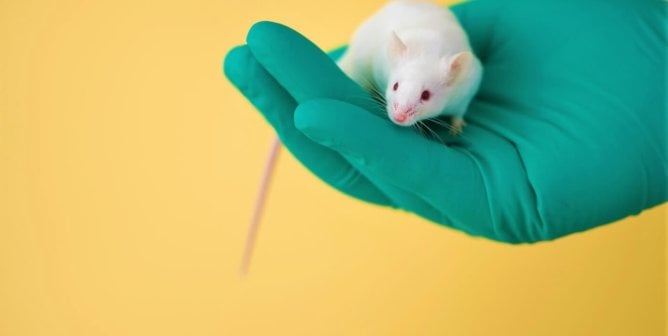9 Brain ‘Studies’ Proving Experimenters Need THEIR Brains Tested
When experimenters “study” animals’ brains, it generally means that they’re drilling holes into animals’ skulls, injecting drugs and toxins directly into their brains, intentionally inflicting brain damage on them (by burning, suctioning out, or mutilating parts of their brains), inserting electrodes or implanting equipment into their brains, or any combination thereof—only to kill them and dissect their brains afterward. These atrocities are often done without adequate pain relief. Can you even imagine? Try to.
The cruelty behind treating sensitive animals as disposable lab equipment is unjustifiable, and these experiments rarely do so much as lead to information that’s even relevant to humans—let alone cures or treatments. The major ethical shortcomings required to inflict such intense harm on other sentient beings, the physiological differences between humans and other animals, and the fact that any data that could potentially be collected from these experiments are limited to the context of a laboratory are all evidence that the animal experimentation industry is riddled with psychopaths who use lab coats as nothing more than a guise to indulge in their depravity legally.
Here are nine twisted brain experiments that expose animal testing for the torturous, wasteful, and meaningless enterprise that it is—while also delaying the development of meaningful treatments and cures for ailing humans:
1. Rat Brain Experiments by Tania Roth at the University of Delaware
The victims: Rats and mice are family-oriented, sensitive, empathetic animals. They speak to each other in squeaks and in high-frequency sounds that are inaudible to the human ear. They become emotionally attached to one other, love their families, and bond easily with their human guardians.
The experiment: One of Tania Roth’s taxpayer-funded “studies” started with her tearing newborn baby rats away from their mothers and placing them with stressed “foster mothers.” Then she had the young females mate. Just one day after the animals gave birth, she cut into the new mothers’ heads, removed part of their skull, and inserted a tube into their brain. Pain relief consisted of a single injection of a painkiller, which was likely highly inadequate for such an invasive procedure. Then a day later, she started pumping a drug into their brains daily for a week. Finally, she observed the mothers’ behavior with their pups for half an hour and then killed and dissected them.

The excuse: To discover how to mitigate the negative effects of early-life child abuse on human parenting. What? Roth even admits that the drug she used can’t cross the blood-brain barrier and had to be administered directly into the brain—making the data from her tests completely meaningless for humans.
2. Monkey Brain Experiments at the National Institutes of Health
The victims: Monkeys live in large family groups, playing, eating, exploring, and hanging out together. Female macaques stay with their mothers for their entire lives, and males do so for several years. They’re intelligent—they’ve learned to use iPhones to look at themselves—and empathetic, often risking their own lives to help others. In 2014, a rhesus monkey in Kanpur, India, was knocked unconscious by overhead power lines, and another rhesus was seen reviving him or her with resuscitative actions.
The experiment: Experimenter Elisabeth Murray cuts into monkeys’ heads, saws off a portion of their skulls, and then injects toxins into their brains to cause permanent and traumatic brain damage. In some monkeys, she suctions out or burns part of the brain. Then she locks the primates alone inside a cramped cage and deliberately frightens them with fake snakes and spiders until they’re eventually killed.
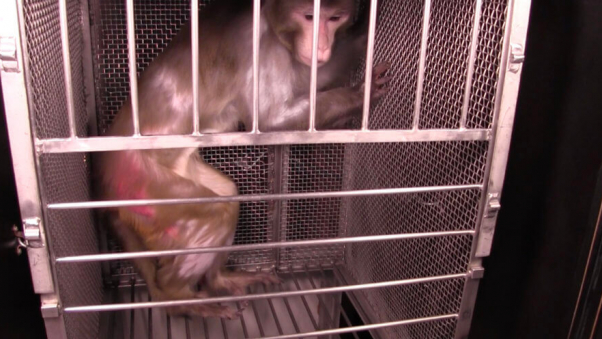
The excuse: Murray claims that her experiments shed light on human neuropsychiatric disorders. Yet after three decades of mutilating, tormenting, and killing monkeys, her laboratory hasn’t developed a single treatment or cure for humans. Still, she has received more than $36 million in the past 13 years alone to terrorize and kill animals.
3. Owl Brain Experiments at Johns Hopkins University
The victims: Owls eat at night, which means that extensive lighting disrupts their hunting patterns. Large, bare branches are prime spots for owls to perch on, and they often make hollow trees their home.
The experiment: Experimenter Shreesh Mysore keeps barn owls caged in a fluorescent-lit basement, where he cuts into their skulls; implants electrodes into their heads; cements a stainless steel bolt to the base of their skulls, which he uses to restrict their head movements; and restrains the fully conscious owls in plastic tubes or tight jackets for up to 12 hours at a time. He clamps their eyes open and bombards them with bursts of noise and light while poking around at neurons in the conscious birds’ brains. He then mutilates their brain tissue so severely by moving the electrodes around that the birds become “unusable” to him—at which point he kills them. He admits that his experiments are painful for the owls.

The excuse: Mysore claims to be studying human attention deficit hyperactivity disorder (ADHD), even though barn owls don’t suffer from the condition and have vastly different auditory and visual systems than humans. Moreover, the owls’ confinement to an unnatural environment and the use of artificial stimulation introduce additional confounding factors. Even so, he’s received more than $1 million in funding from Johns Hopkins University (JHU) and $1.3 million of your tax dollars from the National Institutes of Health.
4. Monkey Brain Experiments at Johns Hopkins University
The victims: Rhesus monkeys in laboratories have been observed starving themselves rather than subjecting their friends to electrocution. In nature, some monkeys place sticks on the ground to indicate to others which trail to follow. Many monkeys go insane inside laboratory cages, exhibiting behavior such as rocking back and forth, pacing endlessly, and making involuntary, spastic movements. They will even self-mutilate, including by tearing their hair out or biting their own flesh.
The experiment: Experimenters at JHU also cut into monkeys’ skulls, covered their brains with a metal plate, and then made two rhesus monkeys use a computer game in which they “gambled” for “drops of juice.” (It’s common for experimenters to restrict animals’ fluid intake in order to coerce them to cooperate.) They then pumped freezing methanol into the metal plate covering their brains. JHU’s violations of the federal Animal Welfare Act (AWA) include isolating highly social monkeys in barren cages as well as causing a number of horrific, accidental deaths.
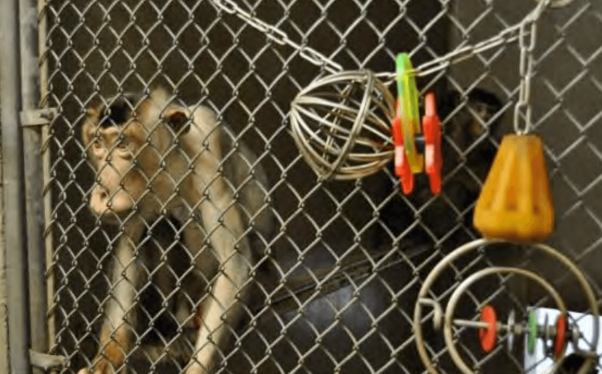
The excuse: This test supposedly could lead to better treatments for humans who exhibit destructive, risky types of behavior. Experimenters found that the monkeys were more likely to choose a “bet” that was high risk but could pay off with more juice, rather than one that was a sure thing. Bravo, JHU. You found a way to torture animals for what could have been easily “discovered” by employing willing human volunteers in non-invasive studies.
What’s more, in response to its campus shutdown because of COVID-19, the university ordered its experimenters to identify “critical animals to be maintained,” presumably leading to the mass killing of countless others who aren’t considered “critical”—which makes us wonder why they were being experimented on in the first place if not even JHU finds these experiments necessary.
5. Monkey, Mice, and Rat Brain Experiments at the University of California–San Francisco
The victims: Male mice woo their mates with high-pitched love songs, and infant rats giggle when they’re tickled. Not only do rats express empathy when someone they know is in distress, they have also been observed preventing other rats from suffering, even when they didn’t know each other and would have to share food.
At the University of California–San Francisco (UCSF), experimenters didn’t provide mice and rats with pain relief before cutting into their skulls. The school’s animal experimenters were also cited for poor monitoring of eight voles, a type of rodent, in a degenerative brain disease study. They were supposed to record signs of disease before euthanizing the animals “at the earliest point possible.” However, no one monitored the infected voles over a weekend. Three of them died of brain disease without yielding any data for the study, and all may have suffered from “discomfort, distress and pain,” federal inspectors said.
The experiments: A rhesus monkey named Peanut was subjected to multiple invasive brain surgeries and was deliberately deprived of food so that he would perform tasks while restrained. He lost 25% of his bodyweight, possibly because he couldn’t chew due to a jaw malfunction, which experimenters only realized after they’d killed him.
Another monkey named Petra was subjected to invasive brain experiments and suffered from a severe infection of the wound left when her head had been cut open. A device implanted in her skull remained in place for seven months, and the veterinarian left screws in her skull for months after it was removed. Experimenters continued to torment her for nearly two years despite her chronic pain. She rapidly began to lose weight, circled endlessly in her cage, and ripped out her own hair. More than a year after that, experimenters found a piece of acrylic that had been left in her head from two years prior. Finally, they euthanized her.

The excuse: Experimenters implanted a device in Petra’s skull so that they could deliver gene therapy for Parkinson’s disease directly to her brain. UCSF receives nearly half a billion dollars a year in taxpayer funds, despite its more than 100 violations of the AWA. Do you know of any cures for Parkinson’s disease? Neither do we.
6. Rat Brain Experiments at the University of Missouri
The victims: Rats make loyal and devoted companions and are even known to put themselves in harm’s way in order to save someone else.
The experiment: Experimenters used rats in weight-training tests by cutting into their heads, removing parts of their skulls, and injecting an inflammatory compound into their brains. They taped heavy weights to the animals’ tails and forced them to climb a 3-foot ladder. The rodents were then subjected to fear-motivated memory tests before being killed.
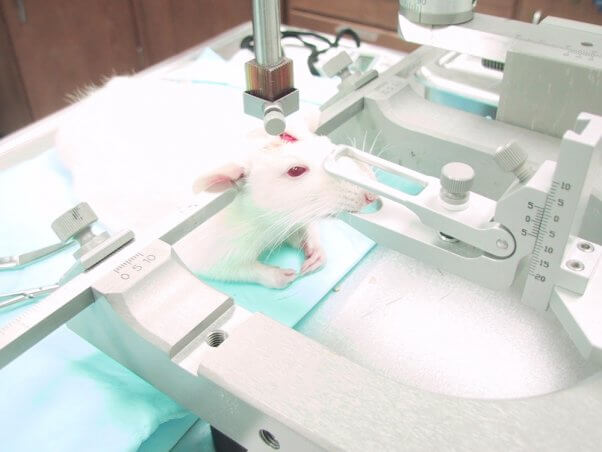
The excuse: To determine whether resistance training (weightlifting) can overcome cognitive deficits—even though multiple studies involving humans have already done so. The benefits of exercise to humans suffering from mild cognitive impairment have been well established, so, good one, Mizzou.
7. Mouse Brain Experiments at the Cleveland Clinic
The victims: Infant mice use ultrasonic sounds to call to their mothers, and female mice sing to one another to help distinguish individuals, much as a human might use their voice to say, “You look familiar. Where do I know you from?” Mice are intelligent, social, and affectionate and will even reciprocate a massage from humans by lovingly grooming their fingers. They become emotionally attached to one another and fiercely protect their families. These bright, curious animals are content to spend hours exploring and playing.
The experiment: Experimenters at the Cleveland Clinic call it a “cranial window,” but what they mean is a hole drilled into the skull exposing the brain and covered with glass. PETA revealed that experimenters suction out portions of mice brains to expose the hippocampus and then place a glass coverslip over the exposed portion. They then glue a stainless steel “head cap” onto the mouse’s skull. The mouse receives pain relief only on the day of the surgery and the next day.
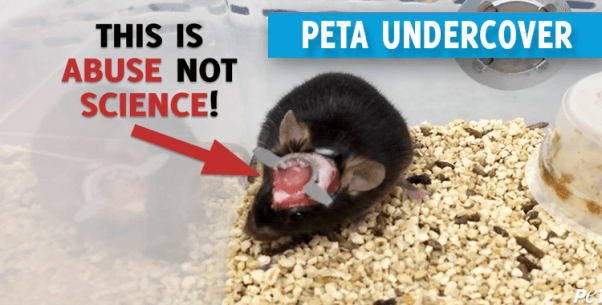
The excuse: These painful, invasive experiments are apparently done to monitor what happens to “the brain condition.” However, the “structure, function, and behavior” of the mouse brain has little relevance to the human brain. In a recent Reuters article on the BRAIN Initiative, Eli Lilly’s vice president of neuroscience research, Dr. Christer Nordstedt, said, “We’ve been handicapped by the fact that we have been studying diseases in animals that don’t really exist in animals. Mice don’t get depression. They don’t get schizophrenia. They don’t get Alzheimer’s disease.”
8. Mice and Rat Brain Experiments Commissioned by the National Football League Foundation, Formerly Known as NFL Charities
The victims: Rats are natural students who excel at learning and understanding concepts and are at least as capable as dogs are of thinking about things and figuring them out. They have excellent memories, and although their eyesight is poor, once they learn a route, they never forget it. Much like us, if they don’t have companionship, they can become lonely and sad. Mice and rats can recognize their names and respond when called, and if rats aren’t forced to live inside a dirty cage, their skin has a very pleasant perfume-like scent.
The experiment: These tests have involved repeatedly slamming heavy weights into rats’ heads to create brain and spinal cord injuries and skull fractures as well as cutting open the heads of mice and delivering crushing blows to cause traumatic brain injuries. The experiments are crudely designed to recreate injuries on the football field.
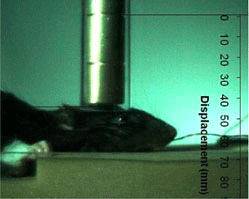
For years, the NFL has quietly funded horrific and deadly sports-injury experiments on dogs, mice, rats, and other animals at Harvard University, the University of Pennsylvania, the University of California–Los Angeles, the University of Notre Dame, and other schools and private laboratories.
The excuse: To prevent and treat injuries sustained by NFL players. But bashing in animals’ heads doesn’t prevent injuries on the football field, as studies have shown that they don’t accurately replicate the complex injuries sustained by football players—and data and treatments derived from brain-injury experiments on animals have repeatedly failed to help human patients.
9. Monkey Brain Experiments at the University of Utah
The victims: Marmosets are highly social creatures who are monogamous, forming family units. The youngsters in the troop help the male take care of the babies, assisting with feeding, carrying, and educating them. They have excellent eyesight and hearing and an acute sense of smell, and they display emotions through their eyelid and ear movements. They also use noises and various high-pitched chirps along with various facial expressions to communicate.
The experiment: A marmoset monkey underwent a highly invasive surgery in the laboratory of Alessandra Angelucci. Laboratory staff tried for up to three hours to find a vein to insert an IV catheter for delivery of fluids. When they couldn’t manage to accomplish this, the experimenters proceeded with the surgery anyway, which included removing a portion of the monkey’s skull and inserting electrodes into his brain. During periods when he was awake for invasive neurological recording, he was repeatedly injected with ketamine, which would have been extremely inadequate for managing pain, and with a paralytic agent to stop eye movement. After the torturous 14-hour surgery and recording, he was dumped back into his cage. Less than 24 hours later, he was dead.
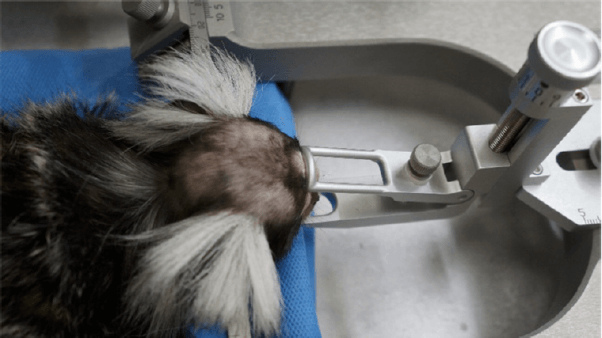
The excuse: Angelucci uses marmosets to study visual information processing (how monkey brains process visual information). The U.S. Department of Agriculture found that this incident constituted a “critical” violation of the AWA, the most severe violation an inspector can identify. However, the university has been allowed to keep all the federal grant money that it was awarded for this project, despite breaking the law.
*****
By comparison with a coin toss, animal experiments are five times worse at predicting the effectiveness of human clinical therapies. Experimenters need to check their own brains, because something is clearly not right there. Their sense of justification and entitlement to inflict inconceivable pain and suffering on sensitive beings is truly incomprehensible. The cruelty is only made worse by the fact that it’s also bad science and a sickeningly huge waste of taxpayer dollars. Animal testing is inexcusable on every conceivable level.
If Not Animals, Then What? Better Science, Better Results
fMRIs and other neuroimaging techniques allow researchers to study the structure and function of human brains, including emotions, memories, and how we learn and process language as well as brain diseases and disorders like Alzheimer’s and Parkinson’s and the effects of different drugs on the brain. This research can be done non-invasively in diverse groups of patients and healthy volunteers. Researchers can safely and non-invasively simulate various conditions such as pain and evaluate brain activity up close. Human imaging studies can be coupled with tissue and cell sampling, micro-dosing, interviews, epidemiological analysis, and other human-centered research methods to glean valuable information from humans—unlike inferior, archaic data derived from crude and inapplicable experiments on animals.
Not only are animal experiments ineffective, their results can also be dangerous when applied to humans. Corticosteroids, for example, were used to treat head injuries in animals, yet in human trials, the treatment increased deaths in newborn babies. Human-based studies spare countless animals’ lives and provide human-relevant data. What are we waiting for? Please sign PETA’s lifesaving Research Modernization Deal petition asking your U.S. legislators to replace the use of animals in experiments with human-relevant methods.


